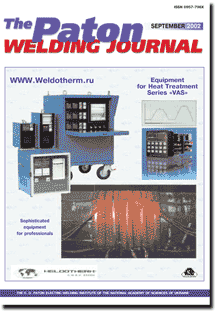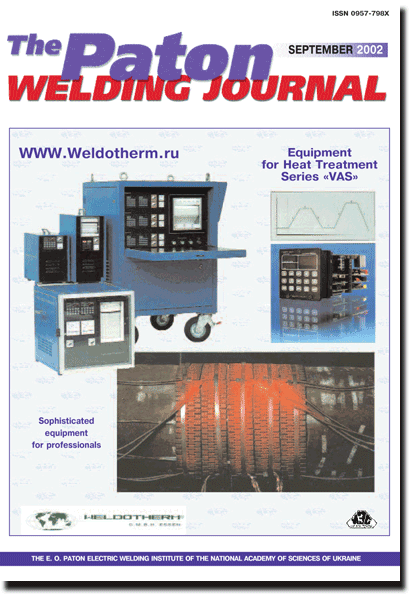

| SCIENTIFIC AND TECHNICAL | |
| Akopiants K.S., Nesterenkov V.M. and Nazarenko O.K. Electron beam welding of 60 mm thick steels using longitudinal oscillations of beam. | 2 |
| Frequency of natural oscillations of molten metal of the weld pool (tens<196>hundreds of hertz) has been estimated. The pulsed effect on the pool providing oscillation of the beam from a tail part of the pool to its leading part has been attained experimentally. Narrow through-penetration welds were made with a penetration depth up to 60 mm, width of about 1 mm and weld shape factor of 40. | |
| Borisov Yu.S., Vojnarovich S.G., Ulianchich N.V., Jensen J. and Wolke J. Investigation of bioceramic coatings produced by microplasma spraying. | 4 |
| Adhesion strength and biocompatibility of bioceramic coatings produced by microplasma spraying was studied. It was established that with the use of a sub-layer the adhesion strength of the hydroxyapatite coatings increased, compared with that of coatings deposited without sub-layer. It is shown that increase in thickness of the coating to 130-160 mm leads to decrease in its adhesion strength down to 4.59 MPa (without sub-layer). High biocompatibility of the microplasma coatings was proved. | |
| Korinets I.F. and Ji Cheng Chung. Mathematical model of technological adaptation of the robot to the gap in arc welding | 7 |
| A deterministic-statistical model was developed of robot adaptation to the gap in consumable-electrode arc welding in a mixture of Ar + 25 % CO2. It may be applied in development of the software of adaptive control systems of robots for MIG and TIG, as well as submerged-arc welding. | |
| Markashova L.I., Arsenyuk V.V., Grigorenko G.M. and Berdnikova E.N. Peculiarities of phase formation in pressure welding of dissimilar metals under conditions of high-rate deforming | 9 |
| Results of investigations into peculiarities of the processes of mass transfer and phase formation in joints of dissimilar metals characterized by a limited mutual solubility (Cu + Al, Ti + stainless steel, St.3 + Al, etc.) are given. The joints were made by pressure welding using high-rate methods of deforming. | |
| Lazebnov P.P. and Pulina N.N. Slime of water-conditioning units of thermal power engineering as raw material for electrode coatings | 15 |
| The paper demonstrates the advantages of thermal power plant slime over marble, which is traditionally applied as gas-slag-forming component of welding consumables. Electrochemical investigations and gravimetric corrosion testing demonstrated the high quality of deposited Cr-Ni metal and the possibility of applying slime in electrode manufacture. | |
| Gulakov S.V. and Nosovsky B.I. On construction of the model of weld pool in consumable-electrode arc welding. | 21 |
| Analysis of statistical and dynamic modes of weld pool was conducted, revealing their contradictions and drawbacks. Calculated and experimental data are given, allowing evaluation of the conditions of weld pool formation in consumable-electrode arc welding. | |
| INDUSTRIAL | |
| Yushchenko K.A., Monko G.G., Starushchenko T.M., Belorusets B.O. and Naumov A.S. Field welding of large-size spherical isothermal tanks for storage of cryogenic products. | 26 |
| Methods for assembly, erection and welding of large-size spherical isothermal tanks of cryogenic application were proposed and implemented. The methods provide a maximum reduction of the scope of assembly-welding operations. A higher efficiency of mechanised welding and labour productivity, as well as shortening of a construction period are achieved. | |
| Bajic D.R., Savitsky M.M., Melnichuk G.M. and Lupan A.F. A-TIG welding of structural steels for power engineering applications. | 30 |
| Efficiency of application of tungsten-electrode inert-gas welding using activating fluxes (A-TIG) for low-alloy carbon and heat-resistant steels was studied. It is shown that increase in the penetrating power of the arc at decreased currents may initiate formation of structural components in the joints which increase strength and decrease ductility of metal. To avoid this effect on structural strength of the joints, it is advisable to subject them to tempering, including the local one, combined with self-pressing to provide a satisfactory geometry of the weld. | |
| Belous V.Yu. Narrow-gap arc welding of titanium alloys (Review). | 35 |
| Experience of practical application of narrow-gap welding of structures of titanium and its alloys has been analyzed. The advantages of the above-mentioned method of welding are shown. Prospects of application of magnetic methods of welding arc control are outlined. | |
| Pismenny A.S., Shinlov M.E. and Yukhimenko R.V. High-frequency power transformers for induction units. | 39 |
| Considered are high-frequency power transformers developed by the E.O. Paton Electric Welding Institute for low- and high-power specialised units. Their design peculiarities are described. Results of comparison of the high-frequency transformers under consideration and commercial-frequency transformers are given. | |
| BRIEF INFORMATION | |
| Sidorenko S.M., Razmyshlyaev A.D. and Maevsky V.R. Distribution of induction of control longitudinal magnetic field in welding T-joints. | 43 |
| In welding of T-joints from ferromagnetic steels a longitudinal component of control longitudinal magnetic field in the arc zone is 2-3 times lower than that in surfacing on flat surface. Optimum sizes of solenoid, generating a longitudinal magnetic field, are defined at which the required level of induction in the welding arc zone in ferromagnetic steel T-joint welding is provided. | |
| Kharchenko G.K., Falchenko Yu.V., Arsenyuk V.V. and Polovetsky E.V. Vacuum percussion welding of aluminium to copper. | 46 |
| Features of mass transfer in vacuum percussion welding of aluminium to copper were studied. A process of joining without formation of intermetallics in the butt was developed. | |
(You are viewing the simplified file contents)
The cost of subscription/purchase order journals or individual articles
| Journal/Currency | Annual Set | 1 issue printed |
1 issue |
one article |
| TPWJ/USD | 384 $ | 32 $ | 26 $ | 13 $ |
| TPWJ/EUR | 348 € | 29 € | 24 € | 12 € |
| TPWJ/UAH | 7200 UAH | 600 UAH | 600 UAH | 280 UAH |
| AS/UAH | 1800 UAH | 300 UAH | 300 UAH | 150 UAH |
| AS/USD | 192 $ | 32 $ | 26 $ | 13 $ |
| AS/EUR | 180 € | 30 € | 25 € | 12 € |
| SEM/UAH | 1200 UAH | 300 UAH | 300 UAH | 150 UAH |
| SEM/USD | 128 $ | 32 $ | 26 $ | 13 $ |
| SEM/EUR | 120 € | 30 € | 25 € | 12 € |
| TDNK/UAH | 1200 UAH | 300 UAH | 300 UAH | 150 UAH |
| TDNK/USD | 128 $ | 32 $ | 26 $ | 13 $ |
| TDNK/EUR | 120 € | 30 € | 25 € | 15 € |
AS = «Automatic Welding» - 6 issues per year;
TPWJ = «PATON WELDING JOURNAL» - 12 issues per year;
SEM = «Electrometallurgy Today» - 4 issues per year;
TDNK = «Technical Diagnostics and Non-Destructive Testing» - 4 issues per year.


